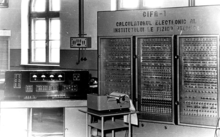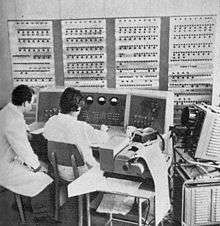CIFA (computer)
CIFA is the acronym for "Calculatorul Institutului de Fizică Atomică" (English: Computer of Atomic Physics Institute).

CIFA-1, the first Romanian computer, was built in 1957 under the guidance of Victor Toma.[1] The experimental first-generation model CIFA-1 was reproduced in small numbers both in the original variant with vacuum tubes as well as in two variants using transistors: CIFA-10X and CET 500.[2]
CIFA-1 made Romania the second socialist country (after USSR) and eighth overall to build an electronic computer.[3][4]
CIFA-1

The logic designs for CIFA-1 started in 1953, at the Academy Physics Institute in Măgurele, with Victor Toma as the head of the project.[1][3] It was presented at the International Symposium in Dresden in 1955, and the prototype, which used 1500 vacuum tubes, a cylindrical magnet memory and machine code programming, was finished in 1957. Its size was that of three wardrobes, it had a paper tape input and a typewriter output and was able of solving 50 operations per second.[5][6]
CIFA-1 was in use for two years. After it was decommissioned, it was scrapped and no part of it survived today.[6][7]
Later computers
Later CIFA computers were CIFA-2 (800 vacuum tubes) in 1959, CIFA-3 (for the Bucharest University's Computer Center) in 1961 and CIFA-4 in 1962.[1] Other Romanian computers of the era are MECIPT and CETA at the Polytechnic Institute of Timișoara, MARICA, DACICC-1 and DACICC-200 at the T. Popoviciu Institute of Numerical Analysis, Cluj-Napoca.[2][3][5][8]
VITOSHA was the first Bulgarian computer, built in 1962-1963 on the basis of a cultural agreement between the Romanian and Bulgarian Academies of Science. It was based on CIFA-3.[3][5]
CIFA Computer Characteristics
| Computer Model | CIFA-1 | CIFA-4 | CIFA-101 | CIFA-102 |
|---|---|---|---|---|
| Year | 1957 | 1962 | 1962 | 1964 |
| Number of computers produced | 4 | 4 | 1 | 5 |
| Semiconductive diodes | 2500 | 3000 | ||
| Vacuum tubes | 800 | 350 | ||
| Computing speed | 50 op/s | 50 - 2000 op/s | ||
| Internal memory type | cylinder 50 rot/s | cylinder 50 rot/s | ||
| Internal memory capacity | 512 words × 4 bits | 4 k words × 4 bits | ||
| Peripherals | • punch card reader 15 characters/s • writer 8 characters/s |
• punch card reader 15 characters/s • writer 8 characters/s |
• punch card reader 100 characters/s • writer 8 characters/s | |
| Number of instructions | 16 | 32 | ||
| Word length | 31 | 32 | ||
| Word processing mode | parallel | serial | ||
| Power utilization | 5 kW | 1 kW | ||
References
- Vințan, Lucian N. (August 2007). "Maeştri ai ingineriei calculatoarelor. Pagini de istorie" (PDF). Univers Ingineresc. 16 (Year XVIII) (398).
- Sandu, Luiza (11 June 2014). "Scurtă istorie a informaticii românești (1957-1990)". Market Watch (165). Retrieved 6 March 2019.
- Drăgănescu, Mihai (2001). "Realizarea de calculatoare şi reţele de calculatoare în România (1953-1985)". Academica. November - December 2001: 43–45.
- Drăgănescu, Mihai (September 2002). "Perspectivele societăţii cunoaşterii în România" (PDF). Communication at the Fifth Scientific Symposium of the Romanian Engineers from Everywhere.
- Baltac, Vasile; Gligor, Horia (19 September 2014). "Some Key Aspects in the History of Computing in Romania" (PDF). Presentation at the 8th IT STAR WS on History of Computing in Szeged.
- Lovin, Tiberiu (13 July 2007). "Tatăl calculatoarelor din țările socialiste". România Liberă. Retrieved 6 March 2019.
- Păvălașc, Marian (16 May 2016). "Originile IT-ul românesc, cel mai performant sector al economiei de azi. Primele calculatoare românești aveau 30 km de cabluri". Libertatea. Retrieved 6 March 2019.
- Cătinaș, Emil (30 November 2018). "Istoricul Institutului de Calcul: Fondarea analizei numerice din România, contribuţii la fondarea informaticii din România". Romanian Academy: Tiberiu Popoviciu Institute of Numerical Analysis. Retrieved 6 March 2019.